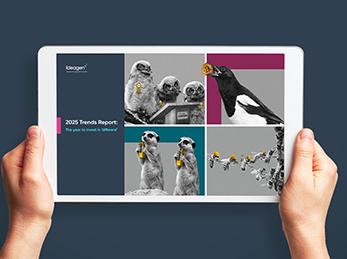The AI skills gap and how to close it
The rapid rise of AI technology has created exciting opportunities for businesses worldwide, revolutionizing how industries operate and maximize efficiency. Yet, with this progress comes a significant challenge – the AI skills gap.
In the process of researching this year's Ideagen 2025 Trends report, the widening gap and the challenges it creates for businesses striving to harness the full potential of AI-driven solutions, came out as a key focus for 2025 and beyond.
Ultimately, AI is advancing at such a rate that business can't keep up with the pace of change.
Recent research by the Boston Consulting Group found that "...when companies undertake digital or AI transformations, they need to focus 70% of their effort and resources on people-related capabilities, 20% on technology, and 10% on algorithms. Too often, companies make the mistake of prioritizing the technical issues over the human ones—which helps explain why many of them do not achieve the results they are looking for."
Understanding the AI skills gap
The AI skills gap refers to the disparity between the growing demand for expertise in AI and the current supply of skilled professionals. This is a two-fold challenge. Firstly, it involves acquiring those AI-specific skills, encompassing a broad range of competencies, from understanding machine learning algorithms and data analysis to the ethical management and oversight of AI systems. And secondly, it includes ensuring that practitioners and professionals understand how to effectively leverage AI capabilities in their day-to-day operations.
Industries like biopharma, energy and supply chain management are said to be among the most affected. For instance, a Deloitte survey revealed that 83% of biopharma supply chain leaders acknowledge the pressing need for upskilling their workforce to support digital transformation. Meanwhile, sectors such as aviation are seeing increased reliance on AI, where operational efficiencies and decision-making have been transformed by this technology.
Challenges of bridging the gap
Addressing the AI skills gap is no easy task. There are several significant challenges:
- Educational limitations
The traditional education system struggles to keep up with the rapid pace of AI advancements. Many curriculums lack up-to-date courses that reflect the latest developments in AI technology, leaving recent graduates ill-prepared for the workforce. - The fast-moving target of AI
AI is evolving at an unprecedented pace. New applications, tools and algorithms emerge constantly, causing a need for continuous learning. Organizations find it challenging to keep their workforce up to date with the latest AI advancements while also managing day-to-day operations. - Automation’s impact on roles
AI adoption is streamlining business structures by reducing middle management. While this cuts costs in the short term, it creates a skills gap in developing new talent – a role traditionally handled by lower-tier leaders. Employees face uncertainty about career growth, making this both a skills and morale challenge.
"Over time, this is a recipe for disaster, as this trend threatens the talent pipeline critical for building a high-performing delivery organization." Frederic Giron, VP, Forrester Senior Research Director
Strategies for addressing the gap
Proactive measures are required to close the AI skills gap. Here are some strategies businesses should consider:
Upskilling and re-skilling employees
Remember that 70% statistic? Smart organizations invest in developing their workforce. Re-skilling helps employees use AI tools effectively, while upskilling prepares them for advanced AI roles. With a growing demand for AI talent and four in five companies ready to pay higher wages for the right skills, it’s more cost-effective to develop talent in-house.
Partnering with technology experts
Re-skilling takes time, but businesses need to act quickly to stay competitive. The solution is partnering with technology providers who can bridge the gap between understanding AI and applying it in real-world scenarios. The right AI tools build on existing knowledge and support employees. For example, AI can analyze large amounts of data and recommend actions that employees can then implement. The AI becomes a ‘subject-matter expert’ in your pocket, helping guide activity and ensure the most valuable use of time.
Creating a balance
Above all, organizations must ensure that AI not only drives efficiency but also complements human expertise. A thoughtful approach that emphasizes ethical considerations and supports displaced workers with transition assistance can help align technological advancements with employee wellbeing.
The road ahead for AI and human expertise
"The journey of AI leaders in 2025 will be dominated by the critical realization that there are no shortcuts to AI success and it will be imperative to prepare for the grind... marrying data and AI strategies, bringing business and technical expertise together, and leveraging partners for excellence." Forrester Predictions 2025
Closing the AI skills gap is a challenge; but it’s also an opportunity with the right business partnerships in place. All we need to do is think differently and act differently.
Ultimately, the key lies in continuous adaptation. Businesses and individuals must commit to learning, evolving and staying ahead of technological shifts. It's one of a number of elements facing businesses in the next 12 months, highlighted in our latest Ideagen report, 2025 Trends: The year to invest in 'different'.

Download the full report
For more insight into what the year holds for high-compliance industries, download the report today.
Download now
Tags:
